The Su-27 was restored after landing on the pylons and flew for a long time.
You are using an out of date browser. It may not display this or other websites correctly.
You should upgrade or use an alternative browser.
You should upgrade or use an alternative browser.
Su-30, Su-33, Su-34 and Su-35 News thread, pictures and discussion
- Thread starter overscan (PaulMM)
- Start date
FighterJock
ACCESS: Above Top Secret
- Joined
- 29 October 2007
- Messages
- 5,577
- Reaction score
- 5,896
So the same thing obviously happened to the Su-34 after it's landing.
Su-34 probably lost its right nozzle
OLS-35 Su-35S on TV mode ( non-IR )maybeView attachment 759270
Su-35S tracked by the Su-34's complex 'Platan' in TV ( LLLTV ?) operating mode.
Su-34 ground-targeting complex 'Platan' in automatic tracking mod. Су-34 Платан.
Please see images below, and discussion here. @QuadroFX
View attachment 758454View attachment 758455Су-35 / Су-35С • Форум "Стелс машины"
Авиация, флот и космос - реальность и перспектива.paralay.iboards.ru
It seems that are new UV-based MAWS similar to that 'Zakhvat' UV MAWS on the Su-25SM3. It seems that UV based MAWS have some advantages over IR based MAWS?
@Saber
''OAR for Su-35 is IIR.''
Btw, SOAR ( OAR) as part of the self-defence electro-optical complex I-222 on the Su-35S are not IIR ( IR-camera,thermovision ) but simple IRST detectors working in the MWIR band ( on Russian 'teplopelengator') with working λ=3-5μm. SOAR detectors can detect incoming aircraft and AAM/SAM's. Smaller SAM ( MANPADS ) can detect from 10km, medium-range AAM/SAM from 30km and bigger/bigger range AAM/SAM from 50km with angle precision 1°.
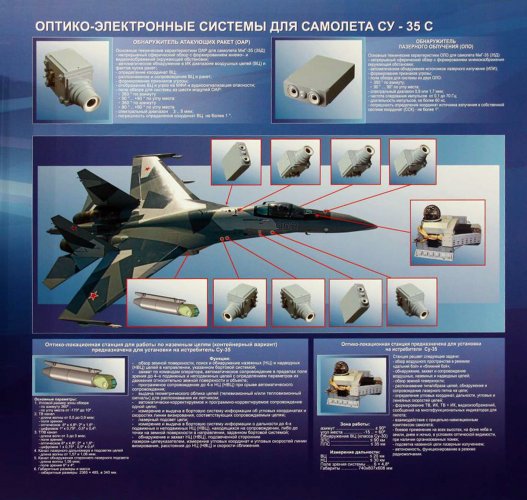
About OLS-35 ( diameter of the optical block is 200mm?), it has MWIR band IRST and there is so many promotive materials etc but there is no real data in them. Only valuable info that I've collected is one interview with the Nikolay Rakitin from the UOMZ in which he said that OLS-35 has four times greater detecting/tracking distances in comparison with the old OLS-27. If that is right what he once said ,we have some valuable data for comparison from the well-known Flight Manual for the Su-27SK with its OEPS-27E ( OLS-27E) .
''Дальность обнаружения истребителя на максимальном режиме работы двигателей на фоне чистого неба в ЗПС под ракурсом 0/4 – 2/4 составляет около 50 км, на фоне облачности,земли и водной поверхности 20 – 35 км, а на форсажном режиме работы двигателей в ППС под ракурсом 1/4 составляет 90 – 100 км. Дальность захвата цели составляет около 70 % от дальности обнаружения. Дальность захвата целей на максимальном режиме работы двигателей в ППС под ракурсом 5° - 15° составляет около 10 км. Для обеспечения большой дальности захвата высокоскоростных целей в ППС необходимо увеличить ракурс атаки более 15°.''
Transl...
''The detection range of a fighter at maximum engine operation mode( Military Power) against a clear sky in the rear hemisphere at an angle spect of 0/4 – 2/4 is about 50 km, against a background of clouds, land and water surface 20 – 35 km, and at afterburner engine operation mode in the front hemisphere at an angle aspect of 1/4 is 90 – 100 km. The target lock-on range is about 70% of the detection range. Target lock-on range at maximum operating mode in the front hemipshere at an angle of 5° - 15° is about 10 km.To ensure a long range of a lock-on of the high-speed targets in the front hemisphere, it is necessary to increase the angle aspect by more than 15°.''
During the first stage of the state military trials ( ГСИ-1) in Akhtubinsk air base in 2011 ,they achieved detection range of 80km against incoming fighter flying in non-AB mode.

Last edited:
About that on-board multifunctional digital interrogator with decimetric L-band AESA type 4283MP for the IFF/ID inside of the wingslats of the Su-35S ,here is some technical details:
It was developed under the Project named Pokosnik or Reaper. It is possible to identify aircraft from the distance of 400km.Working frequency range is 1.03GHz -1.53GHz and it is divided in two frequency subranges.There is two working channels with two different working modes. First channel uses subrange which has working frequency range 1.03GHz-1.46GHz and it is used for the international identification with NATO standard MK-12 system.TRM in this mode has max output pulse power of 700W. Then there is second working channel for the domestic IFF under the Parol system with the frequency subrange 1.46GHz-1.53GHz and with max output pulse power of 500W. Average pulse power for the four-channeled TRM is 350W.Each IFF/ID antenna has three big TRM's with volume of 2.5l each.

One presentation : http://old.aviationunion.ru/Files/Nom_9_GRPZ_2014.pdf


Photo made in KnAAZ where we can see interrogator transmitt antennas of the L-band IFF AESA.

About transponder units (antennas) of the IFF system they are designated as 4280MD-20.There is three black triangled antennas as I've found on this illustration photo of the unknown author.

P.S. As mentioned earlier ,dr Carlo Kopp wrote his article in 2009 but he made mistake because he thought that L band AESA as search radar was integrated in the wingslats of Su-35S.In fact,Su-35S got completely different L band AESA and it is only for IFF.
It was developed under the Project named Pokosnik or Reaper. It is possible to identify aircraft from the distance of 400km.Working frequency range is 1.03GHz -1.53GHz and it is divided in two frequency subranges.There is two working channels with two different working modes. First channel uses subrange which has working frequency range 1.03GHz-1.46GHz and it is used for the international identification with NATO standard MK-12 system.TRM in this mode has max output pulse power of 700W. Then there is second working channel for the domestic IFF under the Parol system with the frequency subrange 1.46GHz-1.53GHz and with max output pulse power of 500W. Average pulse power for the four-channeled TRM is 350W.Each IFF/ID antenna has three big TRM's with volume of 2.5l each.
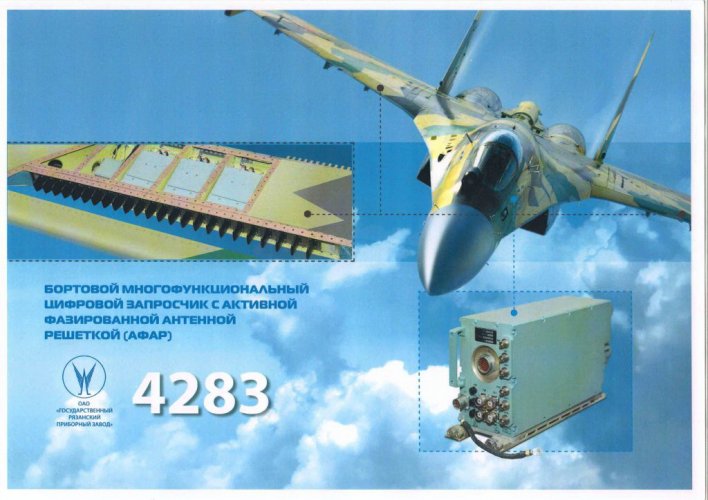
One presentation : http://old.aviationunion.ru/Files/Nom_9_GRPZ_2014.pdf

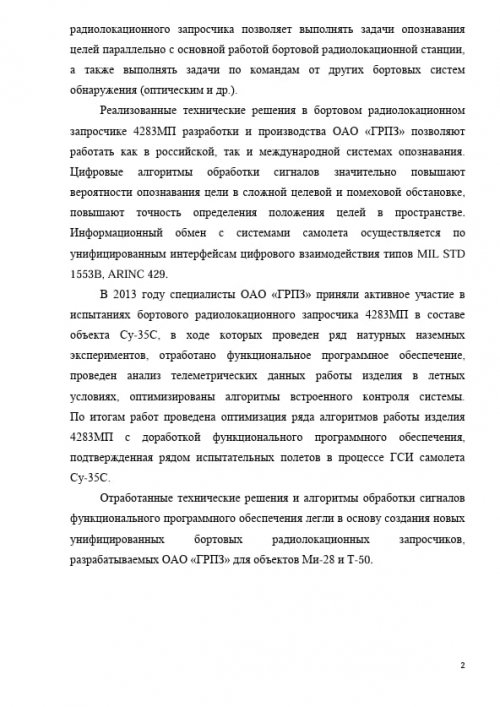
Photo made in KnAAZ where we can see interrogator transmitt antennas of the L-band IFF AESA.
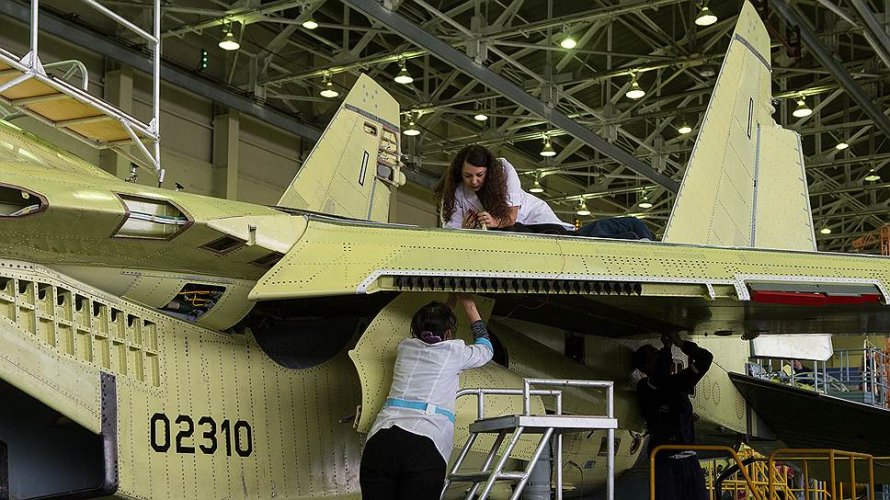
About transponder units (antennas) of the IFF system they are designated as 4280MD-20.There is three black triangled antennas as I've found on this illustration photo of the unknown author.

P.S. As mentioned earlier ,dr Carlo Kopp wrote his article in 2009 but he made mistake because he thought that L band AESA as search radar was integrated in the wingslats of Su-35S.In fact,Su-35S got completely different L band AESA and it is only for IFF.
| Assessing the Tikhomirov NIIP L-Band Active Electronically Steered Array |
Assessing the Tikhomirov NIIP L-Band Active Electronically Steered Array
APA Analysis Paper APA-2009-06; Title:Assessing the Tikhomirov NIIP L-Band Active Electronically Steered Array; Abstract:Tikhomirov NIIP in Moscow are developing an L-band AESA radar system intended for embedding in the leading edges of fighter wings. A demonstrator of the L-band AESA subsystem...
ausairpower.net
New batch of Su-35S, first for this year, has been delivered to VKS. It seems there is no DIRCM as we discussed previously, so it seems Trident was right, it was a case of mistaken conclusion of seeing the undernose MAWS without it's cover. The blurred tail pic also thought to hide a MAWS was only showing the regular comm antenna censored.
View: https://x.com/MrFrantarelli/status/1905858652751143112
View: https://x.com/MrFrantarelli/status/1905858652751143112
New batch of Su-35S, first for this year, has been delivered to VKS. It seems there is no DIRCM as we discussed previously, so it seems Trident was right, it was a case of mistaken conclusion of seeing the undernose MAWS without it's cover. The blurred tail pic also thought to hide a MAWS was only showing the regular comm antenna censored.
View: https://x.com/MrFrantarelli/status/1905858652751143112
Hm, it seems that there is actual new state contract for the delivery of the Su-35S for the RuA&SF ?
First, there was the state contract for 48 Su-35S from 2009, then second from 2015 for 50 Su-35S and there was a third contract worth 70 billion rubles from 2020. It seems that production cost for one Su-35S in KnAAZ was about 2 billion rubles ( 20-25mil$) when we talk about first two contracts? Then after 2020 ,KnAAZ produced 30 new Su-35S for 70 billion rubles until the end of the last year. Some sources wrote that there were two contracts in fact ,one( the third) for the 6 and another (fourth) for 24 new fighters. In total, it is 130 produced and delivered Su-35S so far (128+2 new from today). Production cost after 2020 was higher, 2.5 billion rubles for one?
When we talk about loses,if I'm right, 7 were lost so far during Rus-Ukr war and one was lost on Sakhalin island on 2021.
Canopy open is necesary for evacuation. Remember, Su-34 has bomber-like ingress/egress thru ladder and front chassis bay. SO the only way to leave left is through canopy, and safer way to discard glass is while having enough speed.Well the question is why did it land wheels up with the canopy open. If we can foresee that the result of some battle damages, it would point also to a failed ejection. Something with more consequences.
I think this is more a palliative for a disfunction. A Canopy can protect the crew against the risk of fire the time emergency vehicles arrive on site.
I read somewhere that ejecting the canopy prevented the ejection seats to be triggered during the hard landing. It seems more like something that would motivate a crew to fly top down and crash land.
I read somewhere that ejecting the canopy prevented the ejection seats to be triggered during the hard landing. It seems more like something that would motivate a crew to fly top down and crash land.
Well the question is why did it land wheels up with the canopy open. If we can foresee that the result of some battle damages, it would point also to a failed ejection. Something with more consequences.
Landing of the Su-34 without landing gear.
Before such a landing, the navigator's canopy flap is dropped so that if the plane turns over, the crew can climb out through it, since it is impossible to open it in an inverted position, and the standard exit is closed by the front landing gear.

Fighterbomber
Посадка Су-34 без шасси. Перед такой посадкой сбрасывается створка фонаря штурмана, для того, чтобы если самолёт перевернется, экипаж мог вылезти на улицу через нее, ибо открыть ее в перевернутом положении не представляется возможным, а штатный выход закрыт передней стойкой шасси. Летчик -...t.me
snne
ACCESS: Top Secret
- Joined
- 3 July 2022
- Messages
- 1,385
- Reaction score
- 4,490
Turkish weapons manufacturer Roketsan teases the sale of the LGK-82 PGM Kit to a Flanker-user, i.e. Ukraine(?):
View: https://x.com/aselsan/status/1907408881912787043?t=X1bEY4bXyd5kW2TvAf53MA&s=19


View: https://x.com/aselsan/status/1907408881912787043?t=X1bEY4bXyd5kW2TvAf53MA&s=19
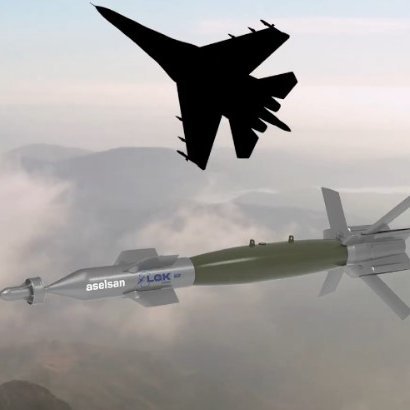

snne
ACCESS: Top Secret
- Joined
- 3 July 2022
- Messages
- 1,385
- Reaction score
- 4,490
Thought that the thread included the original Su-27 as well, can we move this post to the appropriate thread please?Turkish weapons manufacturer Roketsan teases the sale of the LGK-82 PGM Kit to a Flanker-user, i.e. Ukraine(?):
View: https://x.com/aselsan/status/1907408881912787043?t=X1bEY4bXyd5kW2TvAf53MA&s=19
View attachment 765449View attachment 765450
- Joined
- 27 December 2005
- Messages
- 17,712
- Reaction score
- 26,174
1) Other more modern radars do use low PRF radar modes where they make sense. This is all software nowadays.About that LPRF mode, I thought that last known LPRF radar was in fact RP-25 'Smerch-A' from the MiG-25P with max output pulse power of 600kW? If I understand well ,there is no radar today with LPRF mode for A2A combat modes? About MPRF and HPRF modes ,e.g. both of that working modes are used in combat mode called 'Avtomat' or 'Automatic' for the detecting/tracking but only one incoming/receding aircraft. MPRF only is used for the detecting/tracking receding aircraft in the ZPS(Dogon)-SNP or TWS mode and HPRF working mode is used for the detecting/tracking incoming aircraft in the PPS (Vstrechya)-SNP combat mode.Data for the old N001 Myech and N019 Rubin radars.
2) Discussion of specifics of how the N019 and N001 work with medium and high PRFs is completely irrelevant to discussion of modern radars.
I'm pretty sure this video is from 2022-2023.If cold-war tactics are back on the table, Germany should upgrade its Tornados (sarcasm)
Algeria's Su-35 delivery confirmed by satellite imagery:
View: https://x.com/DWatsonfdz/status/1909844793158496378
View: https://x.com/DWatsonfdz/status/1909844793158496378
Algerian AF Su-35 taking off from the Ain Beida AB.
View: https://www.youtube.com/shorts/PI3UbNdZfxQ
Video purpots to show algerian Su-35, just received. Almost certainly real as the algerian posters are usually reliable and don't mess around with PS or DCS stuff. Can't wait to see close up pics.
View: https://x.com/kmldial70/status/1900182772003618846
''Military expert John Pike of GlobalSecurity.org noted in a recent interview that “the Su-35’s combination of range, payload, and sensor technology would give Algeria a significant edge in regional air defense.”
Citation from this article :
Su-35 fighter jet slips into Algeria under official silence

Su-35 fighter jet slips into Algeria under official silence
Reports of Su-35 jets in Algeria spark speculation of a quiet military upgrade, though officials remain silent. Explore the jet’s features and regional impact.
Russian source:
''Таким образом, с большой долей вероятности можно утверждать, что контракт с Алжиром на закупку «египетских» Су-35Э был заключен недавно, после отказа от них Ирана, который в октябре прошлого года заключил контракт на лицензионное производство Су-35 (по сообщениям, около 50 ед.).''
''Thus, it can be stated with a high degree of probability that the contract with Algeria for the purchase of “Egyptian” Su-35Es was concluded recently, after Iran’s refusal to purchase them, which in October of last year concluded a contract for the licensed production of Su-35s (reportedly about 50 units).''
21 Su-35 in the KnAAZ area ( Aug 2022)
From June 2023
''Recent satellite imagery of the Komsomolsk-on-Amur Aviation Plant (KnAAZ) in Russia's Khabarovsk Krai. Clearly visible are 25 Su-35s that were once meant for Egypt.''
View: https://x.com/GuyPlopsky/status/1666578340982177792
We must keep in mind that several Su-35 for the export ( 2-4 pcs) were stationed at Zhukovsky air base from 2021 for the testing.
This is also important detail to consider...
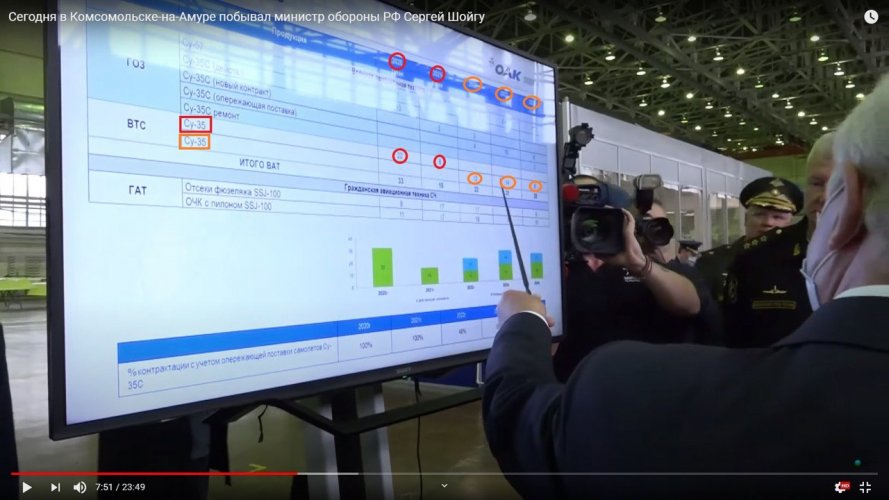

Deliveries of export Su-35s leaked in a video
Deliveries of export Su-35s leaked in a video As part of the the visit of Russian Defense Minister Sergei Shoigu to the KnAAZ aircraft plant in Komsomolsk-na-Amure (Russia), schedu...
If this is right, it seems that KnAAZ already produced 64 Su-35 for the export.
22 in 2020,8 in 2021,12 in 2022, 14 in 2023 and 8 in 2024. Question is ,where are they ?
Last edited:
Hi folks,
World in russian sites is that a Su 35S shot down a Mig 29 from 213km with a R37M. Is there anything behind that claim or is it just wishful thinking on their part?
Regards,
Nic
If we talk about this event ,we must count on some details. Yes ,Russian sources wrote on July 28 2024 that Su-35S shot down Ukr. fighter MiG-29 from a distance of 213km with a heavy hypersonic very long range AAM type R-37M (so the launch distance was 213km). Detection/tracking distance was 270 km ( according to Russian TG-sources ). If that is true ,that is record-breaking launch distance of one AAM against a fighter in the real combat.
So far there were many long range BVR engagements. On Oct. 2022 MiG-31BM shot down Ukr tact. recce. aircraft type Su-24MR with a R-37M.Launch distance was 217 km. On Dec. 2023 MiG-31BM again, shot down Ukr fighter type MiG-29 with R-37M where launch distance was 125km. This YT video is about that event....
We know about that one time when a Mig-31BM shot down a Ukro Mig-29 some 200 kms away...
View: https://youtu.be/ZxAGVMTtQb0?si=eFrZXy6MtPs6SJql
Then on Feb. 2025 Su-30SM2 shot down Ukr fighter type Su-27 with R-37M where launch distance was 130km.
What we know about R-37M ? It is about 600kg heavy hypersonic AAM with max real speed after the acceleration phase of 6 Mach. Has inertial guidance (with midcourse update) in the initial +combined ARH ( Ku-band)/ SARH (X-band) in the terminal phase. What we know about MiG-29/Su-27? Both are 9G-10G capable 4th gen fighters. Now we can ask ourself, can R-37M be used against fighters in the BVR? Of course. Was all this possible?
Very possible in some combat scenario where maybe the pilots of the targeted planes didn't even have an indication that they were illuminated (even locked-on)? RWR known as SPO-15 'Beryoza' can register radar signals in the range of 4GHz-10GHz but ARH mode of the R-37M ( R-77-1 also) ,works in the Ku-band ( 12GHz-18GHz), so we must count on that. We must also count on some data-link possibilities, AAM-launches in the radio-silence mode etc.
Note : max launch distances achieved in the peace time,tests/exercises (if I am right? ):
203km AIM-54A ,F-14A June 1973 ( USN )
244km AIM-54A ,F-14A, January 1979 ( IRIAF)
304km K-37 (Izdeliye 610) ,MiG-31M, April 1994 (RuAF)
Galaxy
ACCESS: Restricted
- Joined
- 14 December 2024
- Messages
- 38
- Reaction score
- 57
Well the story is getting around:

Breaking News: Ukrainian F-16 Fighter Wins First Air-to-Air Fight Shoots Down Russian Su-34
Breaking News: Ukrainian F-16 Fighter Wins First Air-to-Air Fight Shoots Down Russian Su-34armyrecognition.com
Do you even verify anything you post? Feels like Ghost of Kiev all over again. Any time a Russian aircraft crashes you post it here trying to claim it was Ukrainian that were responsible. Military aircraft crash all the time, the US lost hundreds of fighters due to crashes in peace time.
Anyways, what is the range of the AIM-9X? It is about 16km according to the USAF homepage, let’s say they are underestimating the range and it’s really amazing range for a small short range missiles…say 40 KM, well it would still be a difficult task. Okay this is maximum effective range which can be cut in half or more in the real world. Maximum effective range means a missile launched at high speed and high altitude at a target not evading. In the real world, aircraft can’t always exploit the full range of missiles because of air defense threats and enemy aircraft maneuvering and evading which bleeds missile range.
SU-34s have been known to release FABs out to past 70 KM and cruise missiles to at least 120 KMs. This means the F-16 would have to fly deep in Russian controlled territory while facing SAMS, MANPADs, fighters and electronic warfare. Just as crazy, Ukrainian F-16s would have to somehow know when and where SU-34 will be operating so they could intercept them while taking off from relatively far away air bases, we are talking a short window of opportunity given the F-16s range especially since it would likely conduct much of its mission at low altitudes.
Then F-16s would have to get a lock and fire, but why use short range missiles when you can use long range? How would an F-16 survive deep in Russian airspace? Why would Ukraine risk letting an F-16 and its pilot fall into the hands of Russia by operating over Russian controlled areas? And lastly the SU-34 would definitely detect an F-16 and it would definitely try to evade. This means the AIM-9X realistic range would be 8 KMs or less this means Ukrainian F-16 are taking off from around central Ukraine, flying perhaps 50-100 KM inside Russian controlled areas, surviving and for some reason using short range missiles and then magically having enough fuel to get back. Does that make sense?
An F-16 shooting down an SU-34 is not impossible but difficult given the limitations of where Ukrainian F-16 are taking off, air defenses, reactively poor radars found in F-16s and SU-34 stand off weapons and Russia deciding the time and place to launch its SU-34s, again F-16s would have a short window of opportunity and would have to know when those SU-34s are taking off and to where.
FighterBomber discloses Russian aircraft losses honestly. Ukrainians even love using him as a source because there is never any evidence from most of his claims, but even he has clowned on the Ukrainians calling their F-16 shoot downs lies.
Pilots also die all the time due to none combat accidents. You can find hundreds of fatalities involving NATO pilots in piece time.
@Galaxy
In fact only one, confirmed real air victory so far for the UkrAF was achieved in the night of Feb 28 2022 when the Ukr fighter-pilot of MiG-29 Capt. Andriy Gerus shot down with AAM type R-27R his collegue in Su-27 Maj. Stepan Chobanu who was KIA.That happened in the vicinity of the town of Kropivnitsky.Of course UkrAF fighter-pilots of MiG-29,Su-27 and F-16AM shot down many cruise missiles and combat drones.
On the other side, only three RuA&SF Su-35S fighter-pilots have together 17 'air victories'. Lt.Col. Ilya Sizov with 12,Maj Victor Dudin with three and Lt. Ilya Perepelkyn with two.MiG-31BM and Su-30SM/SM2 also shot down some UkrAF combat aircraft.
Most of the UkrAF combat aircraft were shot down by the R-77-1 and there is so many videos (made through IKSh-1M HUD) where we can see that launch distances were 60,80 even 100km.Also we could see that calculated flight time of that AAM from the launch moment until impact was from 90 to 120sec.
G.P. released this 4 days ago ....
View: https://x.com/GuyPlopsky/status/1912090686557700287
In fact only one, confirmed real air victory so far for the UkrAF was achieved in the night of Feb 28 2022 when the Ukr fighter-pilot of MiG-29 Capt. Andriy Gerus shot down with AAM type R-27R his collegue in Su-27 Maj. Stepan Chobanu who was KIA.That happened in the vicinity of the town of Kropivnitsky.Of course UkrAF fighter-pilots of MiG-29,Su-27 and F-16AM shot down many cruise missiles and combat drones.
On the other side, only three RuA&SF Su-35S fighter-pilots have together 17 'air victories'. Lt.Col. Ilya Sizov with 12,Maj Victor Dudin with three and Lt. Ilya Perepelkyn with two.MiG-31BM and Su-30SM/SM2 also shot down some UkrAF combat aircraft.
Most of the UkrAF combat aircraft were shot down by the R-77-1 and there is so many videos (made through IKSh-1M HUD) where we can see that launch distances were 60,80 even 100km.Also we could see that calculated flight time of that AAM from the launch moment until impact was from 90 to 120sec.
G.P. released this 4 days ago ....
View: https://x.com/GuyPlopsky/status/1912090686557700287
More Su-34s for VKS delivered, first batch for this year:
View: https://x.com/MrFrantarelli/status/1913464385193857099
View: https://x.com/MrFrantarelli/status/1913464385193857099
- Joined
- 27 December 2005
- Messages
- 17,712
- Reaction score
- 26,174
This topic is for news about advanced Flanker variants, not discussion of "The Ghost of Kiev".
Scorpion82
ACCESS: Secret
- Joined
- 20 May 2006
- Messages
- 204
- Reaction score
- 378
Are there any halfway reliable information available about the total number of Su-30SM, Su-34 and Su-35S ordered by the RF this far? We had halfway reliable information before about 120 Su-34, similar numver of Su-30SM(2) and 96 Su-35S. All types are apparently still in production and these orders should have been fulfilled already. So more aircraft have definitely been ordered.
Before the war information was usually freely given by Russian mod and UAC. But, understandably, since the war that info sharing stopped.
So no, there is no information out there. There are only hints given, such as production increasing, su34 production more than doubling compared to the rate of two years ago and so on.
Given all that and that we are seeing Russian aircraft sold a abroad, one could assume that domestic bound production is greater than the rate of losses. But by how much, impossible to say. Could be a few dozen planes handed over to ruaf, could be several dozen planes per year.
So no, there is no information out there. There are only hints given, such as production increasing, su34 production more than doubling compared to the rate of two years ago and so on.
Given all that and that we are seeing Russian aircraft sold a abroad, one could assume that domestic bound production is greater than the rate of losses. But by how much, impossible to say. Could be a few dozen planes handed over to ruaf, could be several dozen planes per year.
Are there any halfway reliable information available about the total number of Su-30SM, Su-34 and Su-35S ordered by the RF this far? We had halfway reliable information before about 120 Su-34, similar numver of Su-30SM(2) and 96 Su-35S. All types are apparently still in production and these orders should have been fulfilled already. So more aircraft have definitely been ordered.
When we talk about the Su-30SM/SM2 ,124 Su-30SM were delivered to the RuA&SF/VKS and RNA/MA-VMF so far. 21 new Su-30SM2 were also delivered to the MA-VMF.
ВКС России поставлены новые истребители Су-30СМ2 и учебно-боевые самолёты Як-130
Как сообщило 2 декабря 2023 года ПАО Объединенная авиастроительная корпорация (ПАО ОАК, входит в Госкорпорацию Ростех), входящий в её состав Иркутский авиационный завод (ИАЗ) изготовил и передал Министерству обороны России новые многофункциональные истребители Су-30СМ2 и…
 bmpd.livejournal.com
bmpd.livejournal.com
When we talk about tactical bomber Su-34,there were several state contracts : from 2005 for the delivery of the first 5 serial aircraft. Then 32 Su-34 under the contract from the 2008 and 92 under the contract from the 2012. New Su-34M are delivered under the contract from 2020 with the plan to deliver 76 until the end of 2027.

«Сухой» воздух: Минобороны закупит Су-34 усовершенствованной версии
До 2027 года планируется поставка 76 новейших бомбардировщиков, прошедших модернизацию
When we talk about Su-35S, this is my comment from one earlier post :
''Hm, it seems that there is actual new state contract for the delivery of the Su-35S for the RuA&SF ?
First, there was the state contract for 48 Su-35S from 2009, then second from 2015 for 50 Su-35S and there was a third contract worth 70 billion rubles from 2020. It seems that production cost for one Su-35S in KnAAZ was about 2 billion rubles ( 20-25mil$) when we talk about first two contracts? Then after 2020 ,KnAAZ produced 30 new Su-35S for 70 billion rubles until the end of the last year. Some sources wrote that there were two contracts in fact ,one( the third) for the 6 and another (fourth) for 24 new fighters. In total, it is 130 produced and delivered Su-35S so far (128+2 new from today). Production cost after 2020 was higher, 2.5 billion rubles for one? When we talk about loses,if I'm right, 7 were lost so far during Rus-Ukr war and one was lost on Sakhalin island on 2021.''
Fencer
ACCESS: Restricted
- Joined
- 3 April 2025
- Messages
- 9
- Reaction score
- 20
UAC handed over a batch of new Su-34 fighter-bombers to the Russian Ministry of Defense https://m.vk.com/wall-211699782_24414More Su-34s for VKS delivered
Video https://m.vk.com/video-211699782_456239544?list=d08e86c1e2b1db2e6f&from=post&post=-211699782_24414
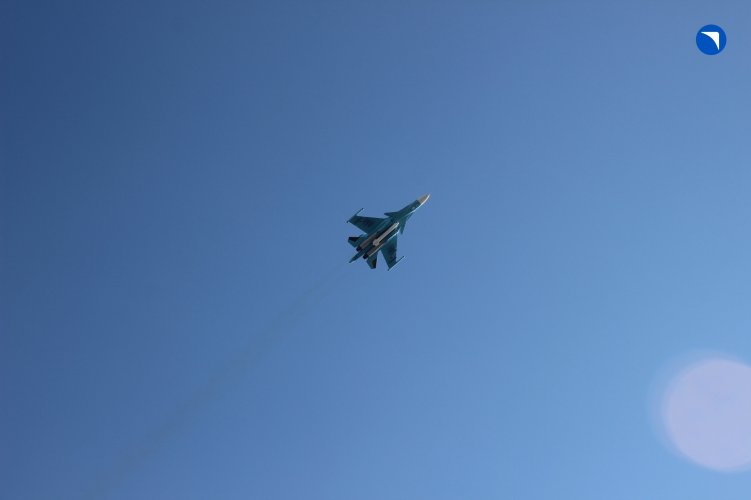

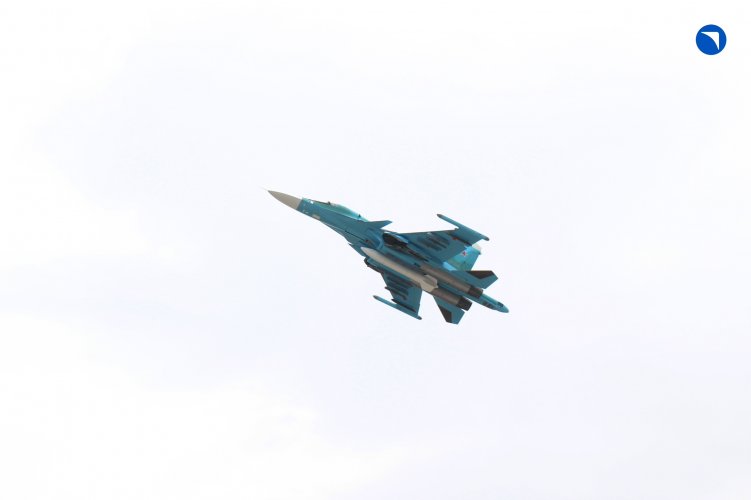
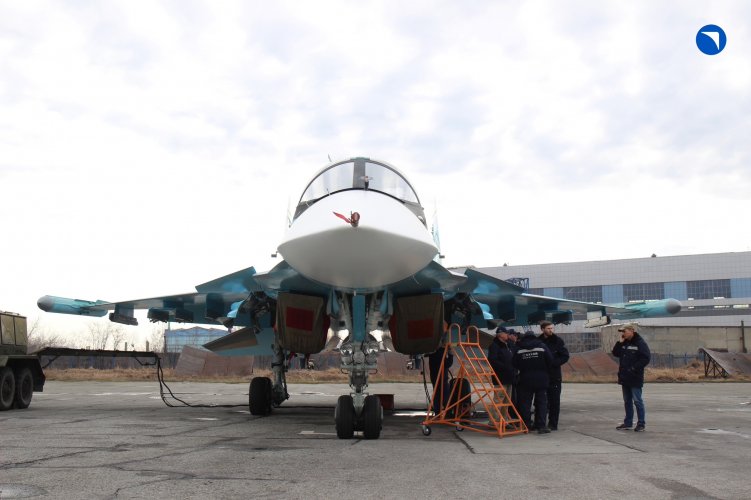
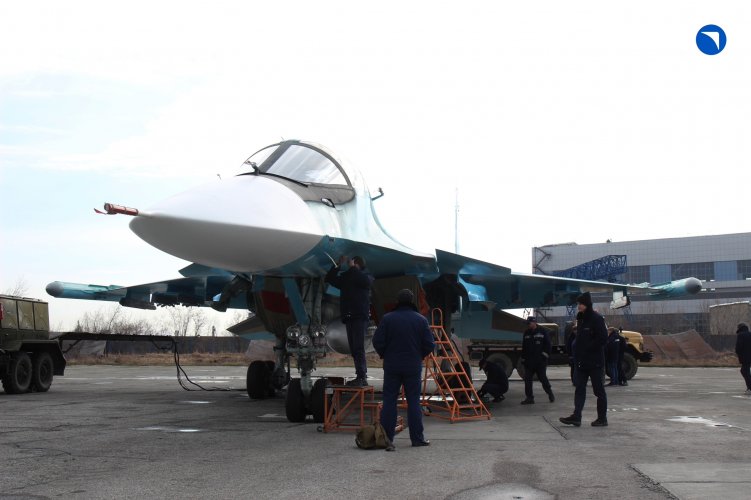
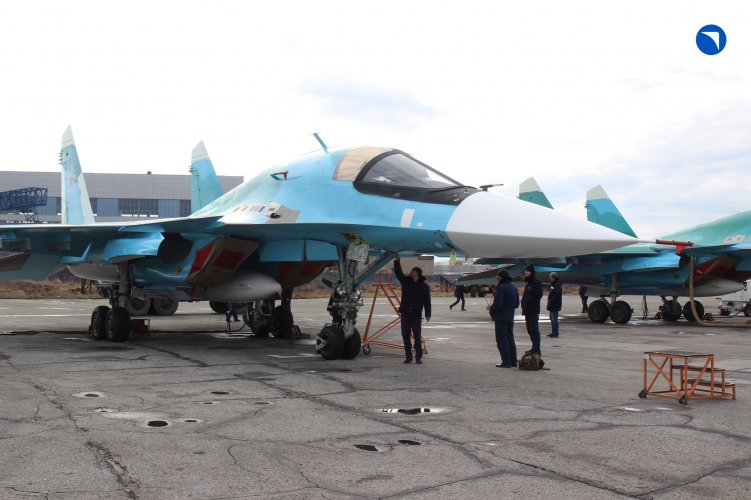
Given that first su34m were handed over in 22, one could assume planned pre war production pace was to roughly 12-13 planes per year.New Su-34M are delivered under the contract from 2020 with the plan to deliver 76 until the end of 2027.
We have that recent uac statement that production increased little over 2 times over compared to 2 years ago. (so that's compared to late 2022 or early 2023)
Which, if taken for a fact, would suggest current su34 pace is roughly 25 or so planes per year. Possibly close to 30.
But. It's also possible that 2022/23 production dipped below pre war plans, due to temporary effects of sanctions. If so, su34 production today might be smaller than 25-30.

